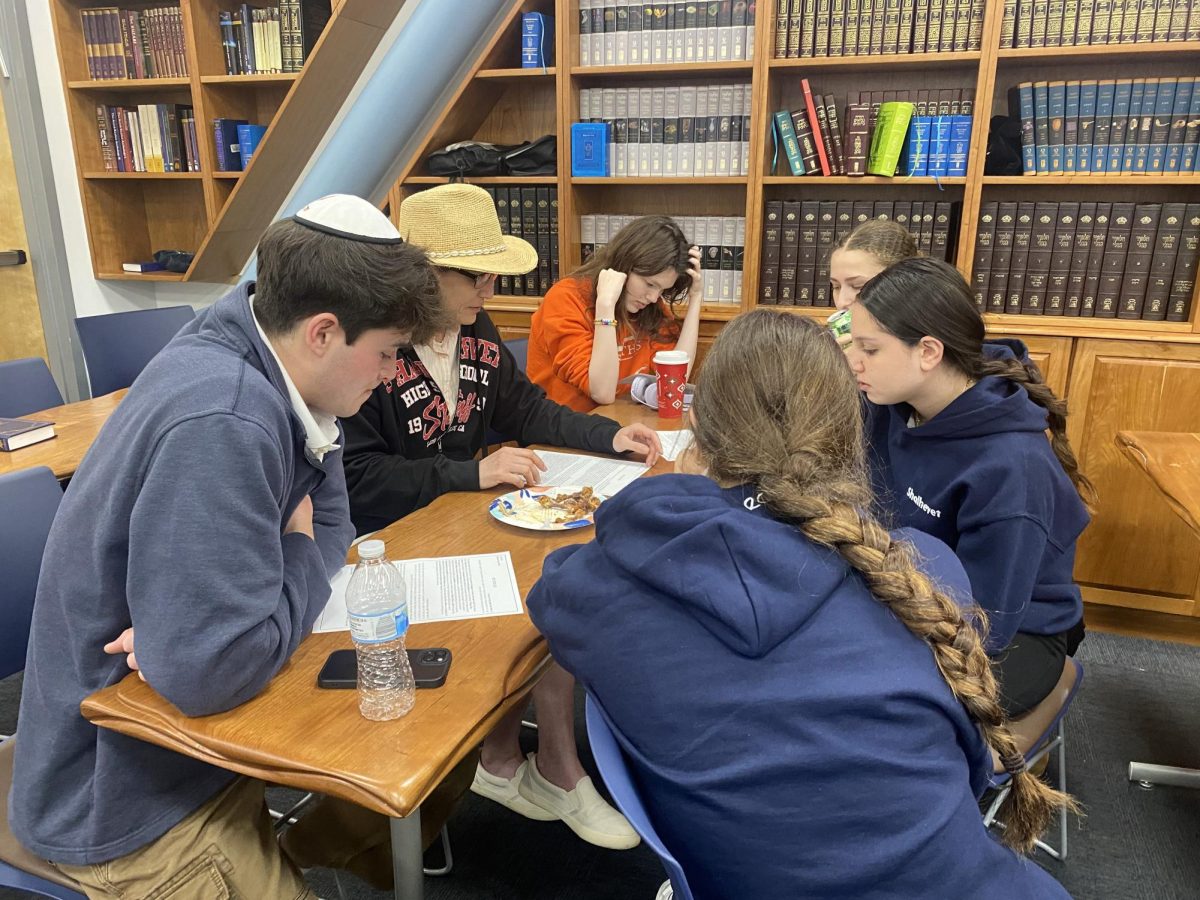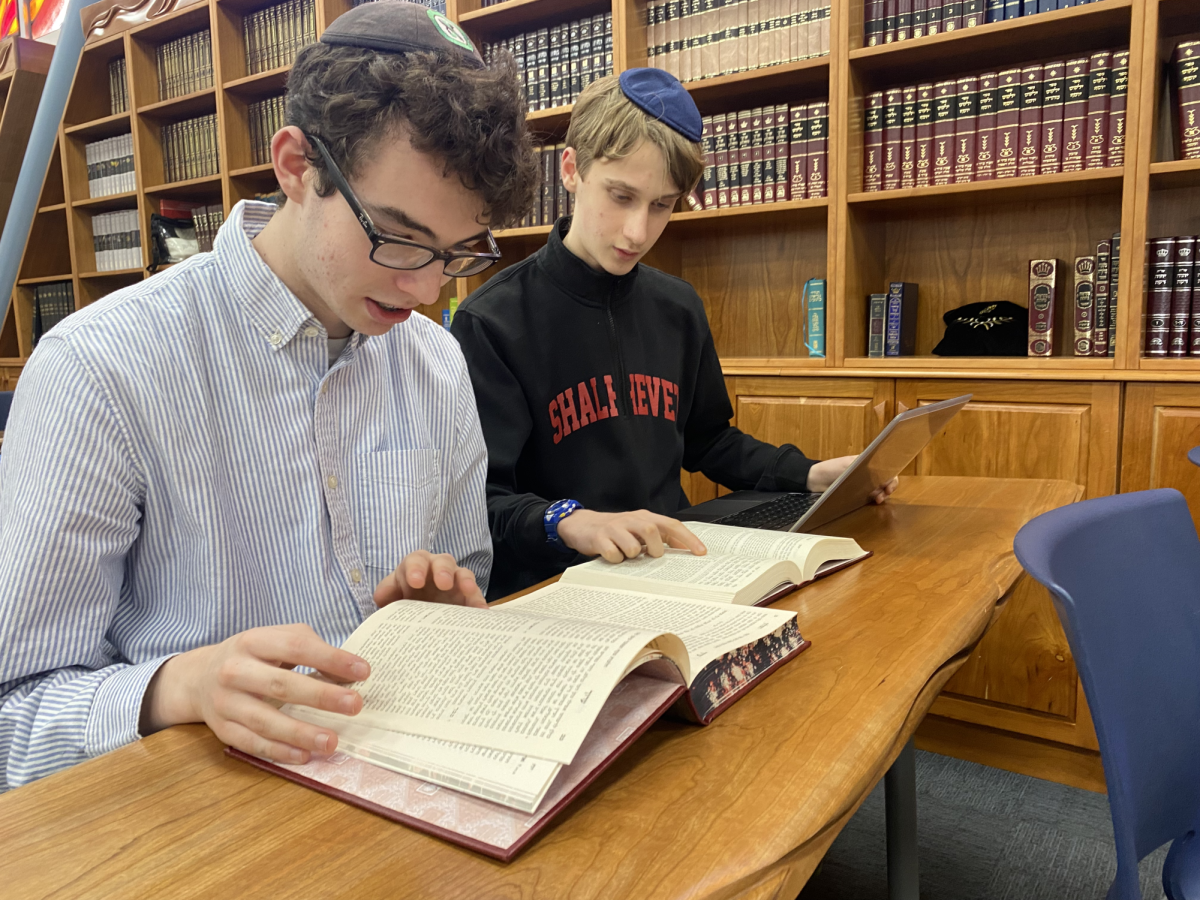It’s 8:47 a.m. Bon Jovi gives the call to prayer over the speaker system as first period ends, and Shalhevet students form two groups. The upperclassmen tackle the empty stretch of hallway toward the Beit Midrash, while the underclassmen head to the Media Center.
In the Media Center, squeezed into tight rows under a low ceiling, ninth- and 10th-grade voices fill the room. Teachers also set the tone – there’s minimal talking, and one look is all it takes for two laughing freshman to change neighbors. A different male student leads almost every day, and his level of experience sets the speed for the davening.
“I really like it,” Rebecca Elspas, freshman, commented. “They sing a lot, and they bang on the chairs to the rhythm of Aleinu.”
Meanwhile, down the hall the upper grades’ minyan is sprawled across the Beit Midrash, more on the talkative side, with plenty of breathing room, and led almost always by the same student chazzanim.
Judaic Studies teacher Rabbi Ari Schwarzberg supervises the upperclass davening, and finds it challenging.
“It’s frustrating, none of us enjoy it,” Rabbi Schwarzberg said. “It’s babysitting – you guys are all 11th and 12th graders and half the time we spend telling you to be quiet.
“But I enjoy seeing everyone in the morning,” he added.
It’s a far cry from previous years’ morning scene, when Shacharit was divided into as many as 10 different minyanim spread out in classrooms around the school. Some years there were separate boys and girls minyans for each grade, in addition to a “happy” minyan full of dancing and singing.
Last year, there were Yoga Minyan, Honors minyan and senior-led Freshman Girls Minyan, in addition to another main minyan for whoever was left.
“The minyanim last year were not well supervised,” Rabbi Leubitz explained. “And mainly, that was a model that spread our faculty resource too thin.”
This year there are usually at least six faculty members in the upperclass minyan and at least four with the underclassmen, including both General and Judaic Studies teachers. Organizing the larger minyans by grade made sense, he said.
“For each grade, just as in other subjects, there are educationally important objectives,” Rabbi Leubitz continued. “So the goal of davening for a 12th grader is not the same as for a ninth grader. That’s why we chose the current set-up.”
Students interviewed held a wide range of opinions, drawing comparisons to the old system as well as to their old schools, shuls and backgrounds. But overall, the changes this year seemed to surprise students, even freshmen whose only experience with Shalhevet was what they’d heard.
“Having the choice is so much better than being forced into this minyan I’d prefer not to be in,” said sophomore Annie Asch, who attended the Yoga Minyan last year.
Freshman Mati Hurwitz would like to see a minyan that was faster, so there would be time to say some of the daily prayers that the group skips – among them, Yehi Kavod, Az Yashir and Shir Shel Yom.
“I think we should limit singing,” suggested freshman Mati Hurwitz, “especially since I’ve noticed that it doesn’t bring more people into the spirit of the davening. Singing means taking additional time to sing different paragraphs, like Ashrei, that don’t need to be sung, and just take up more time.”
Others like the current situation.
Freshman Shoshi Reich finds davening in the underclassmen’s minyan more meaningful compared to the minyan at her previous school.
“We’d only daven three times a week,” Shoshi said. “Everyone would talk the entire time and dread going to davening.”
“I don’t mind the davening set-up this year,” said junior Nicole Ohana. “I was in the regular minyan last year and there’s no difference for me, so I don’t really mind it.”
But many miss the opportunities the previous minyanim offered. For some, being able to choose between more eclectic services meant exposure to new ideas and self-expression.
“I think we should go back to the davening schedule of two years ago,” suggested Adam Wannon, junior. “As we know, not one student at Shalhevet is like the next. [The old system] let them choose what they wanted to do instead of being forced into the Minyanim we have now. It let you get an array of davening experiences.”
Adam has been involved in the student-led effort to start a Sephardic minyan, and expressed frustration at the arduous administrative process. When students asked to restart their separate minyans this year, they were met by an administration that wanted to say yes but hadn’t yet decided how.
“If new minyanim want to form, there has to be a discussion,” Rabbi Leubitz said in late September. “I want students to be able to persuasively write a proper proposal, and work out the logistics.”
Rabbi Leubitz met with Agenda Chair Leona Fallas to devise a system, but that too was an innovation. According to Leona, the Agenda Committee decided to grant a one-week period when potential minyanim could apply for “trial minyanship,” to which Rabbi Leubitz initially agreed.
Delays ensued when a controversy erupted over whether girls would carry the Torah at a Sephardic service, but proponents of other new minyans said their ideas should not have been affected.
“To my knowledge, the current situation is that the minyan process has come to a standstill,” Leona said in mid-October, “but future proposals should probably go through Rabbi Leubitz because he has the final say.”
Finally this past Monday, a revived and revised version of Yoga Minyan reconvened, but it will meet for Shacharit just twice a week instead of every day, and daily for Mincha. The group now has a faculty sponsor, Mrs. Ruthi Skaist.
On Monday, 12 girls – juniors, seniors and two of the sophomores who had been in the group last year – pushed the desks back and sat in a circle on the floor of Room 31.
“When I found out… we were jumping up and down,” Emilie Benyowitz, a previous member of the minyan. “Finally I can think about important things [during davening].”
And yesterday, after meeting Tuesday with Adam and other students to discuss their ideas about the Sephardic minyan and girls Torah-carrying issue, Rabbi Segal announced a daily Sephardic minyan would start soon.
Related: Rabbi Segal okays school’s first Sephardic minyan 10/31/2011
Related: Sephardic minyan approved; no changes to Ashkenazic minyans 10/28/2011






